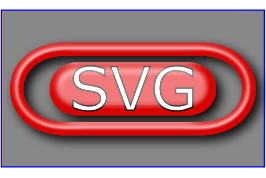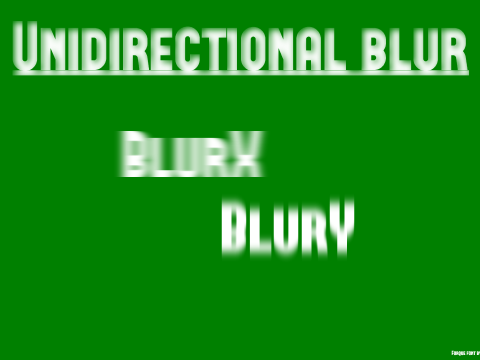Abstract
SVG is language for describing vector graphics, however it's typically rendered on raster displays. SVG filter effects is a way of processing the generated raster image before it's displayed.
Although originally designed for use in SVG, filter effects are defined in XML and are accessed via a presentation property, and therefore could be used in other environments, such as HTML styled with CSS and XSL:FO.
This document introduces the features used by SVG filters.
Status of This Document
This section describes the status of this document at the time of its
publication. Other documents may supersede this document. The latest status
of this document series is maintained at the W3C.
This document is the first public working draft of this specification.
This document has been produced by the W3C SVG Working Group as part of
the W3C Graphics Activity
within the Interaction Domain.
We explicitly invite comments on this specification. Please send them to
public-svg-filters@w3.org (archives).
For comments on the core SVG language, use www-svg@w3.org: the public email list for
issues related to vector graphics on the Web (archives). Acceptance
of the archiving policy is requested automatically upon first post to either
list. To subscribe to these lists send an email to public-svg-filters-request@w3.org
or www-svg-request@w3.org with
the word subscribe in the subject line.
The latest information regarding patent disclosures
related to this document is available on the Web. As of this publication, the
SVG Working Group are not aware of any royalty-bearing patents they believe
to be essential to SVG.
Publication of this document does not imply endorsement by the W3C
membership. A list of current W3C Recommendations and other technical
documents can be found at http://www.w3.org/TR/. W3C publications may
be updated, replaced, or obsoleted by other documents at any time. It is
inappropriate to cite a W3C Working Draft as anything other than a work
in progress."
How to read this document and give feedback
This is a primer for the SVG Filter specification. It gives guidelines on
how to use the SVG Filter specification with SVG 1.2. In many cases the
reader will have to be familiar with the SVG language.
This document is informative.
Table of Contents
1 Filters in SVG
Filter effects are defined by ‘filter’ elements. To apply a filter effect
to a graphics element or a container element, you set the
value of the ‘filter’ property on the given element such that
it references the filter effect.
Each ‘filter’ element contains a set of
filter primitives as its children. Each filter
primitive performs a single fundamental graphical operation (e.g., a blur or
a lighting effect) on one or more inputs, producing a graphical result.
Because most of the filter primitives represent some form of image
processing, in most cases the output from a filter primitive is a single RGBA
image.
The original source graphic or the result from a filter primitive can be
used as input into one or more other filter primitives. A common application
is to use the source graphic multiple times. For example, a simple filter
could replace one graphic by two by adding a black copy of original source
graphic offset to create a drop shadow. In effect, there are now two layers
of graphics, both with the same original source graphics.
When applied to container elements such as ‘g’, the ‘filter’
property applies to the contents of the
group as a whole. The group's children do not render to the screen directly;
instead, the graphics commands necessary to render the children are stored
temporarily. Typically, the graphics commands are executed as part of the
processing of the referenced ‘filter’ element via use of the keywords
SourceGraphic or SourceAlpha.
Filter effects can be applied to container elements with no
content (e.g., an empty ‘g’ element), in which case the
SourceGraphic or SourceAlpha consist of a transparent black
rectangle that is the size of the
filter effects region.
Sometimes filter primitives result in undefined pixels. For example,
filter primitive ‘feOffset’ can shift an image down and to the
right, leaving undefined pixels at the top and left. In these cases, the
undefined pixels are set to transparent black.
2 An example
The following shows an example of a filter effect.
Example filters01 - introducing filter
effects.
<?xml version="1.0"?>
<!DOCTYPE svg PUBLIC "-//W3C//DTD SVG 1.1//EN"
"http://www.w3.org/Graphics/SVG/1.1/DTD/svg11.dtd">
<svg width="7.5cm" height="5cm" viewBox="0 0 200 120"
xmlns="http://www.w3.org/2000/svg" version="1.1">
<title>Example filters01.svg - introducing filter effects</title>
<desc>An example which combines multiple filter primitives
to produce a 3D lighting effect on a graphic consisting
of the string "SVG" sitting on top of oval filled in red
and surrounded by an oval outlined in red.</desc>
<defs>
<filter id="MyFilter" filterUnits="userSpaceOnUse" x="0" y="0" width="200" height="120">
<feGaussianBlur in="SourceAlpha" stdDeviation="4" result="blur"/>
<feOffset in="blur" dx="4" dy="4" result="offsetBlur"/>
<feSpecularLighting in="blur" surfaceScale="5" specularConstant=".75"
specularExponent="20" lighting-color="#bbbbbb"
result="specOut">
<fePointLight x="-5000" y="-10000" z="20000"/>
</feSpecularLighting>
<feComposite in="specOut" in2="SourceAlpha" operator="in" result="specOut"/>
<feComposite in="SourceGraphic" in2="specOut" operator="arithmetic"
k1="0" k2="1" k3="1" k4="0" result="litPaint"/>
<feMerge>
<feMergeNode in="offsetBlur"/>
<feMergeNode in="litPaint"/>
</feMerge>
</filter>
</defs>
<rect x="1" y="1" width="198" height="118" fill="#888888" stroke="blue" />
<g filter="url(#MyFilter)" >
<g>
<path fill="none" stroke="#D90000" stroke-width="10"
d="M50,90 C0,90 0,30 50,30 L150,30 C200,30 200,90 150,90 z" />
<path fill="#D90000"
d="M60,80 C30,80 30,40 60,40 L140,40 C170,40 170,80 140,80 z" />
<g fill="#FFFFFF" stroke="black" font-size="45" font-family="Verdana" >
<text x="52" y="76">SVG</text>
</g>
</g>
</g>
</svg>Example  |
View this example as SVG (SVG-enabled browsers only)
The filter effect used in the example above is repeated here with
reference numbers in the left column before each of the six filter
primitives:
1
2
3
4
5
6
| <filter id="MyFilter" filterUnits="userSpaceOnUse" x="0" y="0" width="200" height="120">
<desc>Produces a 3D lighting effect.</desc>
<feGaussianBlur in="SourceAlpha" stdDeviation="4" result="blur"/>
<feOffset in="blur" dx="4" dy="4" result="offsetBlur"/>
<feSpecularLighting in="blur" surfaceScale="5" specularConstant=".75"
specularExponent="20" lighting-color="#bbbbbb"
result="specOut">
<fePointLight x="-5000" y="-10000" z="20000"/>
</feSpecularLighting>
<feComposite in="specOut" in2="SourceAlpha" operator="in" result="specOut"/>
<feComposite in="SourceGraphic" in2="specOut" operator="arithmetic"
k1="0" k2="1" k3="1" k4="0" result="litPaint"/>
<feMerge>
<feMergeNode in="offsetBlur"/>
<feMergeNode in="litPaint"/>
</feMerge>
</filter>
|
The following pictures show the intermediate image results from each of
the six filter elements:

Source graphic
| | 
After filter primitive 1
| | 
After filter primitive 2
| | 
After filter primitive 3
|
| | | | | | | |
| | | 
After filter primitive 4
| | 
After filter primitive 5
| | 
After filter primitive 6
|
- Filter primitive ‘feGaussianBlur’ takes input SourceAlpha,
which is the alpha channel of
the source graphic. The result is stored in a temporary buffer named
"blur". Note that "blur" is used as input to both filter primitives 2 and
3.
- Filter primitive ‘feOffset’ takes buffer "blur", shifts
the result in a positive direction in both x and y, and creates a new
buffer named "offsetBlur". The effect is that of a drop shadow.
- Filter primitive ‘feSpecularLighting’, uses buffer "blur"
as a model of a surface elevation and generates a lighting effect from a
single point source. The result is stored in buffer "specOut".
- Filter primitive ‘feComposite’ masks out the result of
filter primitive 3 by the original source graphics alpha channel so that
the intermediate result is no bigger than the original source
graphic.
- Filter primitive ‘feComposite’ composites the result of
the specular lighting with the original source graphic.
- Filter primitive ‘feMerge’ composites two layers together.
The lower layer consists of the drop shadow result from filter primitive
2. The upper layer consists of the specular lighting result from filter
primitive 5.
3 Filter primitive ‘feGaussianBlur’
The ‘feGaussianBlur’ filter primitive can be used to create blur effects.
Below is an example where the blur is applied only in one direction, which can
give better performance in some user agents.
<?xml version="1.0" encoding="UTF-8"?>
<svg xmlns="http://www.w3.org/2000/svg" xmlns:xlink="http://www.w3.org/1999/xlink" viewBox="0 0 480 360">
<defs>
<font-face font-family="FORQUE">
<font-face-src>
<font-face-uri xlink:href="Forque.svg#FORQUE"/>
</font-face-src>
</font-face>
<style>
/* Free font by Tup Wanders, http://www.tupwanders.nl, Licensed with a Creative Commons attribution license. */
text { text-anchor: middle; font: 70px FORQUE, sans-serif; }
#bx { filter: url(#blurX) }
#by { filter: url(#blurY) }
#header { filter: url(#ds); fill: white; text-decoration: underline }
#attribution { font-size: 6px }
:root { background: green; fill: white }
</style>
<filter id="blurX" x="0" y="20%" width="100%" height="1.5em" filterUnits="userSpaceOnUse">
<feGaussianBlur stdDeviation="4 0">
<animate attributeName="stdDeviation" values="8 0;20 0;0 0" keySplines="0.25 0.1 0.25 1" keyTimes="0;0.5;1" calcMode="spline" dur="4s" begin="bx.click" fill="freeze"/>
</feGaussianBlur>
</filter>
<filter id="blurY" x="0" y="0" width="100%" height="100%" filterUnits="userSpaceOnUse">
<feGaussianBlur stdDeviation="0 4"/>
</filter>
<filter id="ds" x="-0.1" y="-0.1" width="1.2" height="1.2">
<feGaussianBlur stdDeviation="3"/>
<feOffset dx="2" dy="2"/>
<feComposite in2="SourceGraphic" operator="in"/>
</filter>
</defs>
<text id="bx" x="40%" y="50%">BlurX</text>
<text id="by" x="60%" y="70%">BlurY</text>
<text id="header" y="1em" x="50%">Unidirectional blur</text>
<text id="attribution" x="100%" y="355">Forque font by Tup Wanders</text>
</svg>Example  |
View this example as SVG (SVG-enabled browsers only)
The blur filter can also be used for creating the impression of something being in motion, as in this example.
<?xml version="1.0" encoding="UTF-8"?>
<svg xmlns="http://www.w3.org/2000/svg" xmlns:xlink="http://www.w3.org/1999/xlink" viewBox="0 0 480 360">
<defs>
<filter id="motionblur" filterUnits="userSpaceOnUse">
<feGaussianBlur stdDeviation="5 0"/>
</filter>
<symbol id="crow" viewBox="0 0 197 190">
<path d="M 72.566789,186.38448 C 71.202549,184.36785 66.167569,175.06788 61.377949,165.71788 C 56.588329,156.36788 52.650829,149.03965 52.627949,149.43293 C 52.605069,149.82621 53.231819,152.07621 54.020719,154.43293 C 56.134749,160.74826 59.591199,174.77158 59.554549,176.88449 C 59.524869,178.59503 59.416409,178.58387 57.935879,176.71788 C 55.201299,173.27137 45.853349,153.1995 41.635529,141.71788 C 37.663679,130.90581 37.605079,130.81611 38.205719,136.46788 C 38.959899,143.56439 37.583169,143.96813 34.795769,137.46788 C 30.104179,126.52701 28.892829,118.89987 27.609109,92.21788 C 26.579279,70.81278 27.181269,61.74079 30.007419,56.07564 C 31.906109,52.26963 32.139109,52.60152 20.824699,42.99574 C 13.205099,36.52681 11.734279,35.68694 7.1852392,35.20738 L 2.0863492,34.66985 L 7.5863492,32.82094 C 10.611349,31.80405 13.481709,30.60949 13.964929,30.16638 C 15.394959,28.85504 9.7899892,24.44625 4.4291292,22.66566 C 1.6943392,21.75731 -0.28374076,20.75464 0.033389242,20.43751 C 0.35051924,20.12038 7.2421692,19.78442 15.348169,19.69093 C 30.881569,19.51179 34.937409,20.13958 47.086349,24.60361 C 50.936349,26.01826 55.713159,27.18519 57.701489,27.19679 C 65.982349,27.2451 71.556499,17.90344 69.368439,7.6442896 C 67.940739,0.95023961 69.214399,0.010319613 79.726899,2.961339e-05 C 85.523249,-0.0056403866 91.246029,0.80265961 98.391539,2.6362896 C 104.0594,4.0907296 112.29453,5.9632196 116.69184,6.7973796 C 134.01279,10.0831 145.35739,15.11226 132.4653,13.78988 C 123.72653,12.89352 125.97985,14.08978 145.54774,20.73521 C 161.35384,26.10311 174.7538,32.06177 176.16916,34.35187 C 176.71697,35.23824 175.39586,35.37836 170.91088,34.90959 C 167.61644,34.56525 164.05819,34.00702 163.00367,33.66907 C 159.44558,32.52878 164.45052,35.98642 172.8528,40.47328 C 181.01437,44.83161 187.58635,49.6841 187.58635,51.35196 C 187.58635,51.95969 185.75677,52.07923 182.83635,51.6623 C 177.61881,50.91742 177.61253,50.9017 184.83635,56.66751 C 189.29595,60.22701 191.15689,64.23449 188.33635,64.20466 C 187.64885,64.19739 183.75408,62.28489 179.6813,59.95466 C 175.60852,57.62443 170.43352,54.66077 168.1813,53.36875 C 160.24766,48.81749 155.25808,48.53915 153.96805,52.57585 C 153.59155,53.75397 153.17397,57.05515 153.04009,59.91181 C 152.72526,66.62933 148.47286,73.16418 144.39537,73.19653 C 141.27521,73.22129 140.06261,74.55103 141.84736,75.99069 C 143.5779,77.38662 163.91595,85.24612 177.08635,89.60855 C 183.13635,91.61249 189.88635,94.27223 192.08634,95.51908 C 196.03044,97.75438 196.08764,97.86951 196.17774,103.75198 C 196.32804,113.55263 191.83044,119.99235 183.2058,122.3255 C 179.71567,123.26966 178.08026,123.11668 172.50059,121.32412 C 165.62068,119.11384 161.59126,116.76556 147.7546,106.9026 C 143.17214,103.63615 137.09714,100.07812 134.2546,98.99585 L 129.08635,97.0281 L 124.58635,102.12335 C 122.11135,104.92574 119.27183,107.21844 118.2763,107.21824 C 117.28078,107.21804 114.25803,108.66351 111.55908,110.4304 C 108.02382,112.74478 106.47184,114.49211 106.00784,116.6804 C 105.6536,118.35101 104.7976,120.39288 104.10563,121.21788 C 102.12794,123.57575 99.866059,134.66955 99.008439,146.21788 C 98.702099,150.34288 97.981489,154.68231 97.407089,155.86106 C 96.606229,157.50454 96.855109,159.32029 98.474539,163.64858 C 99.636029,166.75296 100.58635,170.19015 100.58635,171.28678 C 100.58635,174.34075 97.802589,174.76966 95.009829,172.14599 L 92.535069,169.82107 L 94.060709,174.1452 C 97.730759,184.54723 95.140999,185.2202 87.992199,175.72216 C 84.864209,171.56625 82.136779,168.33411 81.931259,168.53964 C 81.725729,168.74517 82.756989,171.5332 84.222939,174.73527 C 87.061249,180.93494 87.859979,187.23913 85.894459,187.92805 C 85.215209,188.16613 81.485349,182.83448 77.222469,175.53184 C 73.108409,168.48416 69.042179,161.81788 68.186409,160.71788 C 66.764029,158.88956 66.749579,159.06125 68.018079,162.71788 C 68.781269,164.91788 70.803819,170.06041 72.512649,174.14572 C 77.734689,186.63018 77.767619,194.07236 72.566789,186.38448 z"/>
</symbol>
</defs>
<image xlink:href="forest-small.jpg" width="100%" height="100%" filter="url(#motionblur)"/>
<use xlink:href="#crow" width="25%" height="25%" x="20%" y="40%" transform="rotate(-12)"/>
</svg>Example  |
View this example as SVG (SVG-enabled browsers only)
4 References
- SVG12
- Scalable Vector Graphics (SVG) 1.2 Specification,
Dean Jackson editor, W3C, 27 October 2004 (Working Draft). See http://www.w3.org/TR/2004/WD-SVG12-20041027/
- SVG12Reqs
- SVG 1.1/1.2/2.0 Requirements, Dean Jackson editor,
W3C, 22 April 2002 (Working Draft). See http://www.w3.org/TR/2002/WD-SVG2Reqs-20020422/
- SVGFilterReqs
- SVG Filter Requirements, Erik Dahlström, W3C, 3 May 2007
(Working Draft). See http://www.w3.org/TR/2007/WD-SVGFilterReqs12-20070501/
- SVG12Filters
- SVG Filters 1.2, Erik Dahlström editor, W3C, 3 May 2007 (Working Draft). See http://www.w3.org/TR/2007/WD-SVGFilter12-20070501/









